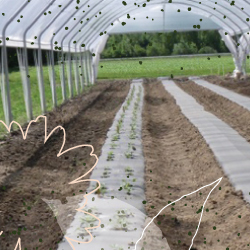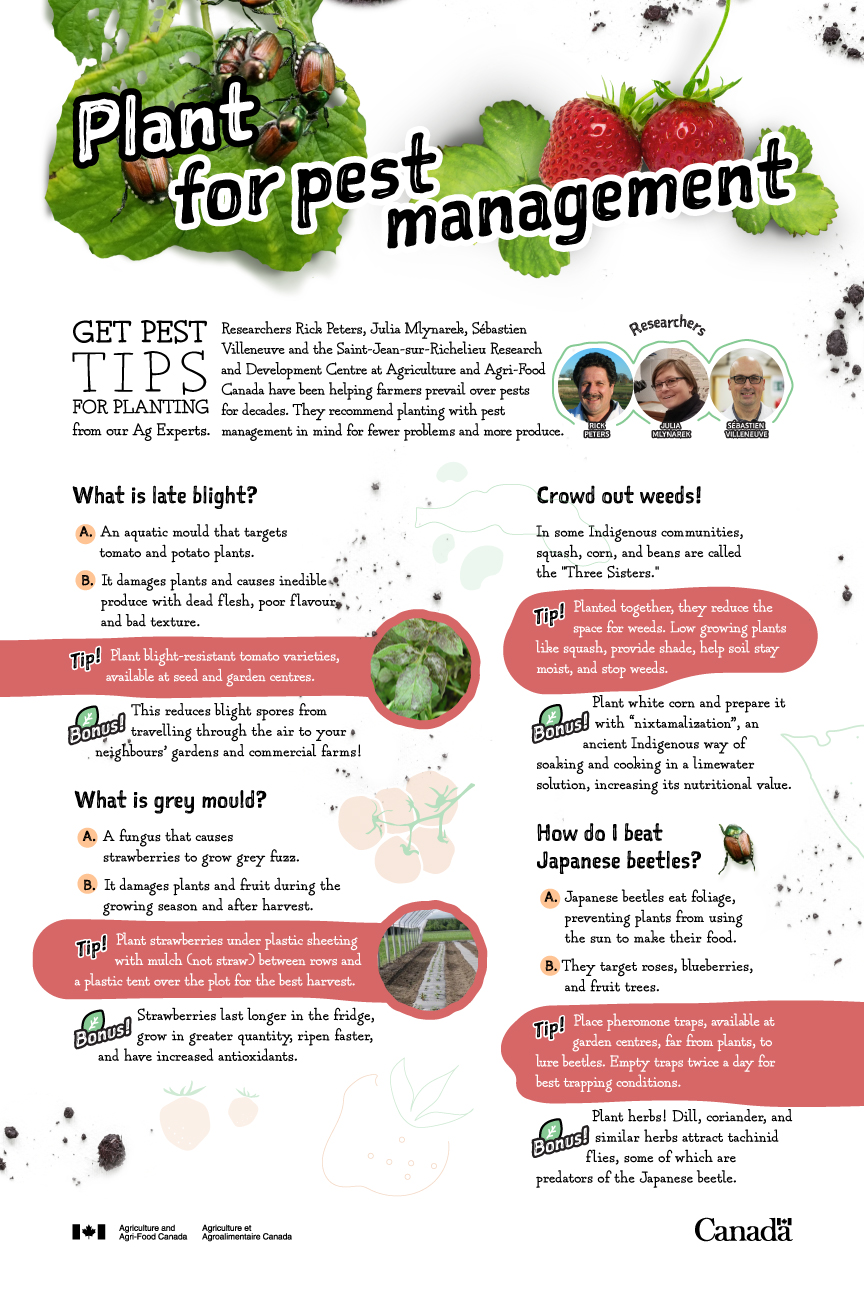June 11, 2020
Agriculture and Agri-Food Canada's (AAFC) wealth of agricultural research supports farmers and food processors as they put food on Canadian tables. As more Canadians take to their gardens as part of physical distancing measures during the COVID-19 period, we are sharing a series of gardening tips based on our research. Our first tips discussed soil preparation.
After you've set up your garden soil, it's time to plant. Our researchers agree — planting with pest management in mind from the start will save you problems later in the season. An ounce of pest prevention is worth a pound of produce!
Battle blight in tomatoes and potatoes
Late blight is an aquatic mould that targets tomato and potato plants. Its Latin name, Phytophthora infestans, translates as "the plant destroyer" and it was the major culprit of the Irish Potato Famine in the 1840s. It causes plant damage and a crop with dead flesh, off flavour, and a grainy texture, rendering it largely inedible.
The disease is spread by spores that can travel on the wind or be splashed onto plants by rainwater, ruining acres of crops in a matter of weeks. It's particularly damaging to Canada's potato sector.
"Planting blight-resistant tomato seeds or plants is the best way to avoid harvest time disappointment," recommends Dr. Rick Peters. These are available at seed and garden centres.
You'll reap the rewards of a ripe, healthy tomato crop in September and have done your part to reduce blight spores from travelling through the air from your garden to your neighbours' and helping Canada's farmers stay blight-free!
Manage mould on strawberries
Strawberries are one of summer's sweetest treats. But they also often fall victim to grey mould — that fuzzy fungus that appears on your berries once they're picked, but starts in your garden bed.

According to research from AAFC's St. Jean-sur-Richelieu Research Centre, you can minimize grey mould and get the best from your berries using a simple method at planting time. You'll need plastic sheeting, row covers, and mulch from a local garden centre. Lay the plastic sheeting over your garden rows and cut an 'X' or circle through the plastic for each strawberry plant. Next, apply mulch, not straw, between the rows. Straw can be a perfect home for mould in humid climates. Finally, put your plastic row covers over your strawberry patch.
By planting this way, your strawberries will be exposed to less grey mould and last longer in your fridge. As a bonus, they'll ripen faster, grow larger, glossier, and have increased anti-oxidants and polyphenols (compounds often claimed to possess anti-cancer properties).
Indigenous insight to winnow out weeds
In the first part of this Digging in series, we talked about the Indigenous "Three Sisters" planting trio and how planting corn, squash, and beans together helps build and maintain soil health. Dr. Sébastien Villeneuve says, "This same planting system will help you battle weeds, as well."
Squash grows low and trailing across the ground. Its leaves shade the ground, helping your garden in two ways: shaded soil loses less water and weed seeds won't germinate where they can't access light.
Always place short leafy plants at the base of plants that will grow taller for less weeding and more relaxing.
Battle beetles with pheromones

Did you know that 1 in 5 of all known life forms on earth is a beetle? Chances are, you'll run into a few in your garden. Many are helpful garden allies who recycle soil nutrients, help with composting, and eat bad bugs like aphids and slugs. But, other beetles are garden adversaries who feed on plants and crops, ruining harvests.
If you live in Eastern or Central Canada, you may be fighting the Japanese beetle. Recognized by its metallic green head and metallic copper wings with six tufts of white hairs along either side of the abdomen, it' an invasive species that skeletonizes foliage on roses, blueberries and many fruit trees. In their larval stage, they munch on the roots of grasses, ornamentals, and vegetables.
"Pheromone traps are an effective strategy for battling beetles," says Dr. Julia Mlynarek. Available at garden centres, these traps should be placed far from your plants, as their seductive scent will lure many beetles. Empty and clean the traps regularly (up to twice a day) so beetles have room to enter and be trapped. If they find the trap full, they'll wander off to feast on your foliage instead.
In her research against the Japanese beetle, Dr. Mlynarek has found that planting extra herbs is also a deterrent. "Herbs from the carrot family, like dill and coriander, attract a tachinid fly (similar to a house fly) that is a predator of the Japanese beetle."
We hope these tips will help you plan(t) for a successful gardening season. For more information, refer to our handy gardening tips sheet and stay tuned for our next installment of gardening tips from AAFC experts!
Related links
Get more Agri-info
- Want more stories like this? Explore what else Agri-info has to offer.
- Interested in reporting on this story? Contact AAFC Media Relations at aafc.mediarelations-relationsmedias.aac@agr.gc.ca to arrange an interview with one of our experts.
